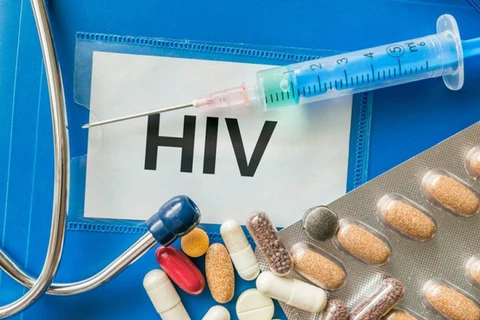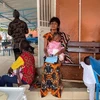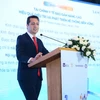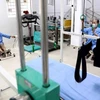 Health insurance policy helps people living with HIV ease burden on treatment cost (Photo: VietnamPlus)
Health insurance policy helps people living with HIV ease burden on treatment cost (Photo: VietnamPlus)
Hanoi (VNA) - Vietnam is the first country in the Asia-Pacific region to commit to realising the 90-90-90 target set by the United Nations.
The 90-90-90 goal means 90 percent of all people living with HIV know their HIV status, 90 percent of all people with diagnosed HIV receive sustained antiretroviral therapy, and 90 percent of all people receiving antiretroviral therapy will have viral suppression
According to the Ministry of Health’s Department of HIV/AIDS Prevention and Control, realising the 90-90-90 target is extremely important in preventing HIV/AIDS and eliminating it by 2030.
The number of people living with HIV in the community is estimated to be about 250,000. Of them, 213,097 or 85 percent of the total were aware of their status as of September. Nearly 151,000 HIV-infected people were aware of their status have undergone antiretroviral (ARV) therapy, accounting for 75 percent, while 96 percent of ARV-treated patients have had the virus suppressed.
The country, therefore, needs to continue making every effort to have 95 percent of HIV carriers aware of their status, 95 percent of whom are to access sustained ARV therapy and 95 percent of such patients are to have the virus suppressed.
The targets are key to efforts to erase AIDS in Vietnam by 2030, in accordance with the National Strategy on HIV/AIDS Prevention and Control to 2030.
Dr Hoang Dinh Canh, Deputy Director of the Vietnam Administration of HIV/AIDS Control (VAAC) under the Ministry of Health, said since the first infection was detected in 1990 in Ho Chi Minh City, there are 213,008 HIV carriers who are still alive and 107,812 deaths from HIV/AIDS in Vietnam. The country now has about 11,000 new HIV cases and about 2,800 HIV/AIDS-related deaths yearly.
 Dr Hoang Dinh Canh, Deputy Director of the Vietnam Administration of HIV/AIDS Control (VAAC) under the Ministry of Health. (VietnamPlus)
Dr Hoang Dinh Canh, Deputy Director of the Vietnam Administration of HIV/AIDS Control (VAAC) under the Ministry of Health. (VietnamPlus)
In the eight months of 2020, 7,090 new HIV cases were detected nationwide while the number of fatalities was 1,392. The newly discovered was mainly in the age group of 16-29 (45 percent) and 30-39 (31 percent). HIV infection due to unprotected sex was the most common cause of transmission (76 percent), through blood (11 percent), and from mother to child (1.1 percent), while the rest has no information on transmission route.
Men having sex with men (MSM) is being warned as one of the main risk groups of the HIV epidemic in Vietnam at present.
 Thuan An medical centre (Binh Duong province) provides health care for 789 out patients with HIV/AIDS. (Photo: VietnamPlus)
Thuan An medical centre (Binh Duong province) provides health care for 789 out patients with HIV/AIDS. (Photo: VietnamPlus)
Canh highlighted the country’s efforts in curbing the spread of HIV/AIDS over the past 30 years, saying that the Prime Minister on August 14 approved the National Strategy on HIV/AIDS Prevention and Control to 2030, which target an end to the AIDS epidemic by 2030.
Moreover, the National Assembly adopted a law amending and supplementing certain articles to the Law on HIV/AIDS Prevention and Control on November 16, 2020.
Over the past years, the health sector has expanded HIV testing, while maintaining consultations and technical assistance for key provinces.
As of June 30, 2020, medical establishments had provided consultation services for more than 1.7 million people, including over 15,800 HIV carriers, or 0.91 percent.
Canh said the HIV/AIDS epidemic in the community has continued to ease while HIV testing services have been expanded and diversified, helping to detect about 10,000 new HIV cases.
Besides, social organisations’ participation in HIV/AIDS prevention and control has also been enhanced, the treatment of opioid addiction maintained and reformed, and the provision of PrEP (pre-exposure prophylaxis) for HIV prevention implemented very well.
The antiretroviral (ARV) therapy has also been further expanded with higher quality, he noted, adding that more than 153,000 patients have successfully changed the ARV therapy from free drugs to those covered by health insurance.
However, Canh also acknowledged certain difficulties in the HIV/AIDS combat such as the emergence of new groups with high-risk behaviour, the shortage of personnel for prevention and control efforts, and the shortage of funding due to foreign sponsors’ aid reduction.
This year’s national action month, from November 10 to December 10, is themed “30 years of response to and opportunities to end the AIDS epidemic in Vietnam”, as 2020 is the 30th year since the first HIV infection was recorded in the country, according to the VAAC.
Given this, the national action month is an important occasion for Vietnam and partners to review HIV/AIDS prevention and control attainments during the last three decades and learn lessons from them, the VAAC noted.
It said that there will be a number of practical activities to be held during the month, including a conference reviewing the 30 years of anti-HIV/AIDS efforts which will also mark the national action month and World AIDS Day (December 1).
Authorities will also present gifts to disadvantaged children infected with HIV or affected by the epidemic at a treatment centre in Hanoi’s Ba Vi district.
In the national strategy for ending AIDS by 2030, Vietnam targets to bring the number of newly detected HIV infections to under 1,000 each year, the fatalities linked with HIV/AIDS less than one per 100,000 people, and that HIV/AIDS will be no longer a public health concern./.
























